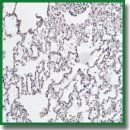
A Study of Biocompatibility of Acellular Matrices of Primate Lungs and the Potential for Their Application as Tissue-Engineering Constructions
The aim of the study was to evaluate biocompatibility of acellular matrices on the model of primate lungs, which is closely approximated to human lungs in terms of anatomic-morphological characteristics, for the purpose of creating tissue engineering constructions.
Materials and Methods. Acellular matrix was obtained from detergent-enzymatic decellularization of primate lungs according to a modified protocol, where exposition time and detergent concentration were increased. The quality of the obtained scaffold was morphologically evaluated after staining with hematoxylin and eosin and DAPI fluorophore, and by testing the assay for residual DNA. The change in the composition of decellularized extracellular matrix was quantitatively evaluated during the registration of the square area of positive staining after immunohistochemical testing and during staining with alcian blue. Biocompatibility of scaffolds was tested with XTT assay after 48 and 72 h of static recellularization with a consequent quantitative determination. As the main cellular resource for colonization of the scaffolds, we used multipotent mesenchymal stem cells of primates whose cellular affiliation was verified by immunophenotyping and targeted differentiation.
Results. Morphological testing did not reveal any considerable structural damage of the scaffolds, residual DNA was 19.2%. Quantitation of the square area of positive staining revealed a statistically significant decrease in the amount of type I collagen and the vascular endothelium growth factor (VEGF) after decellularization. Quantitative changes in extracellular matrix were registered, however they do not impair biocompatibility of the scaffolds and do not affect cell activity.
Conclusion. The obtained scaffolds do not have cytotoxic properties, they contribute to adhesion, growth and metabolic activity of cells, which allows us to consider acellular matrices to be a potential for creating tissue engineering constructions of lungs after additional enhancement of the protein composition.
- Ignatova G.L., Zakharova I.A., Sarsenbayeva A.S., Rodionova O.V., Grebneva I.V., Drozdov I.V., Blinova E.V., Minakina O.L., Antonov V.N., Belsner M.S., Pustovalova I.A. Features of chronic bronchitis in different age groups. International Journal of BioMedicine 2014; 4(1): 15–18.
- Wagner D.E., Bonvillain R.W., Jensen T., Girard E.D., Bunnell B.A., Finck C.M., Hoffman A.M., Weiss D.J. Can stem cells be used to generate new lungs? Ex vivo lung bioengineering with decellularized whole lung scaffolds. Respirology 2013; 18(6): 895–891, https://doi.org/10.1111/resp.12102.
- Sokocevic D., Bonenfant N.R., Wagner D.E., Borg Z.D., Lathrop M.J., Lam Y.W., Deng B., Desarno M.J., Ashikaga T., Loi R., Hoffman A.M., Weiss D.J. The effect of age and emphysematous and fibrotic injury on the re-cellularization of de-cellularized lungs. Biomaterials 2013; 34(13): 3256–3269, https://doi.org/10.1016/j.biomaterials.2013.01.028.
- Booth A.J., Hadley R., Cornett A.M., Dreffs A.A., Matthes S.A., Tsui J.L., Weiss K., Horowitz J.C., Fiore V.F., Barker T.H., Moore B.B., Martinez F.J., Niklason L.E., White E.S. Acellular normal and fibrotic human lung matrices as a culture system for in vitro investigation. Am J Respir Crit Care Med 2012; 186(9): 866–876, https://doi.org/10.1164/rccm.201204-0754oc.
- Bonenfant N.R., Sokocevic D., Wagner D.E., Borg Z.D., Lathrop M.J., Lam Y.W., Deng B., Desarno M.J., Ashikaga T., Loi R., Weiss D.J. The effects of storage and sterilization on decellularized and recellularized whole lung. Biomaterials 2013; 34(13): 3231–3245, https://doi.org/10.1016/j.biomaterials.2013.01.031.
- Kuevda E.V., Gubareva E.A., Sotnichenko A.S., Gumenyuk I.S., Gilevich I.V., Polyakov I.S., Porhanov V.A., Alekseenko S.N., Macchiarini P. Experience of perfusion recellularization of biological lung scaffold in rats. Russian Journal of Transplantology and Artificial Organs 2016; 18(1): 38–44, https://doi.org/10.15825/1995-1191-2016-1-38-44.
- Wagner D.E., Bonenfant N.R., Sokocevic D., DeSarno M.J., Borg Z.D., Parsons C.S., Brooks E.M., Platz J.J., Khalpey Z.I., Hoganson D.M., Deng B., Lam Y.W., Oldinski R.A., Ashikaga T., Weiss D. Three-dimensional scaffolds of acellular human and porcine lungs for high throughput studies of lung disease and regeneration. Biomaterials 2014; 35(9): 2664–2679, https://doi.org/10.1016/j.biomaterials.2013.11.078.
- O’Neill J.D., Anfang R., Anandappa A., Costa J., Javidfar J., Wobma H.M., Singh G., Freytes D.O., Bacchetta M.D., Sonett J.R., Vunjak-Novakovic G. Decellularization of human and porcine lung tissues for pulmonary tissue engineering. Ann Thorac Surg 2013; 96(3): 1046–1056, https://doi.org/10.1016/j.athoracsur.2013.04.022.
- Kuevda E.V., Gubareva E.A., Sotnichenko A.S., Gilevich I.V., Gumenyuk I.S., Sharkova T.V., Кaral-ogly D.D., Orlov S.V., Macchiarini P. Nonhuman lung decellularization: protocol optimization. Mezhdunarodnyy zhurnal prikladnykh i fundamental’nykh issledovaniy 2015; 8: 244–247.
- Badylak S.F., Taylor D., Uygun K. Whole-organ tissue engineering: decellularization and recellularization of three-dimensional matrix scaffolds. Annu Rev Biomed Eng 2011; 13: 27–53, https://doi.org/10.1146/annurev-bioeng-071910-124743.
- Kuevda E.V., Gubareva E.A., Krasheninnikov S.V., Grigoriev T.E., Gumenyuk I.S., Sotnichenko A.S., Gilevich I.V., Karal-ogly D.D., Orlov S.V., Chvalun S.N., Redko A.N., Alekseenko S.N., Macciarini P. Evaluation of the influence of decellularization on the changes in biomechanical properties of primate lungs. Doklady Biochemistry and Biophysics 2016; 470(1): 375–378, https://doi.org/10.7868/s0869565216300289.
- Ruifrok A.C., Johnston D.A. Quantification of histochemical staining by color deconvolution. Anal Quant Cytol Histol 2001; 23(4): 291–299.
- Bonvillain R.W., Danchuk S., Sullivan D.E., Betancourt A.M., Semon J.A., Eagle M.E., Mayeux J.P., Gregory A.N., Wang G., Townley I.K., Borg Z.D., Weiss D.J., Bunnell B.A. A nonhuman primate model of lung regeneration: detergent-mediated decellularization and initial in vitro recellularization with mesenchymal stem cells. Tissue Eng Part A 2012; 18(23–24): 2437–2452, https://doi.org/10.1089/ten.tea.2011.0594.
- Gilpin S.E., Guyette J.P., Gonzalez G., Ren X., Asara J.M., Mathisen D.J., Vacanti J.P., Ott H.C. Perfusion decellularization of human and porcine lungs: bringing the matrix to clinical scale. J Heart Lung Transplant 2014; 33(3): 298–308, https://doi.org/10.1016/j.healun.2013.10.030.
- Nichols J.E., Niles J., Riddle M., Vargas G., Schilagard T., Ma L., Edward K., La Francesca S., Sakamoto J., Vega S., Ogadegbe M., Mlcak R., Deyo D., Woodson L., McQuitty C., Lick S., Beckles D., Melo E., Cortiella J. Production and assessment of decellularized pig and human lung scaffolds. Tissue Eng Part A 2013; 19(17–18): 2045–2062.










